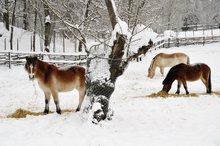With newspaper, internet, and TV news stories focused on the dire winter circumstances that have devastated the cattle industry in South Dakota, horse and livestock owners everywhere need to consider the fact that a catastrophe can strike nearly anywhere at any time.

Importance of being prepared for weather disasters
According to reports the early-autumn blizzard killed as many as 80,000 head of cattle making it South Dakota's worst economic disaster in decades.
As reported, thousands of cattle including bulls, cows and calves were caught unaware and unprotected when a blizzard swept through acres of ranch land where animals were not protected from the freezing, wet elements. On Friday, October 11, 2013, as rain pelted the region near the historic Black Hills, cattle ranchers began scouring the back country as they attempted to collect carcasses of dead cattle.
According to reports the early-autumn blizzard killed as many as 80,000 head of cattle making it South Dakota's worst economic disaster in decades as the storm savaged the $7 billion livestock industry in the state.
Every year, weather events and disasters affect hard working horse owners, the cattle industry and other animal-centered enterprises. Whether it is loss of electricity, impassable roads, breaks in communication, floods, fires, tornadoes, hurricanes and other natural disasters can devastate an area quickly and, often without warning.
Although the storm that brought devastation to South Dakota, struck early and with little warning, making it impossible for cattle owners to move their cattle to safety before it took its toll, now is a good time for every horse owner to review disaster plans that will keep family, employees, and horses safe in the event of a weather disaster.
Horse and animal owners should be prepared for a number of situations including:
The AAEP has well-thought-out Disaster Plans that work well, not only for horse owners, but for all farmers and animal owners.
